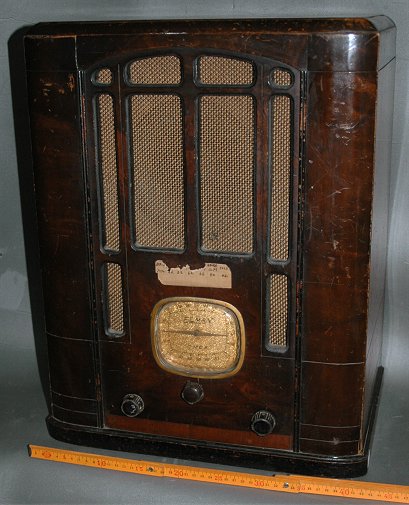
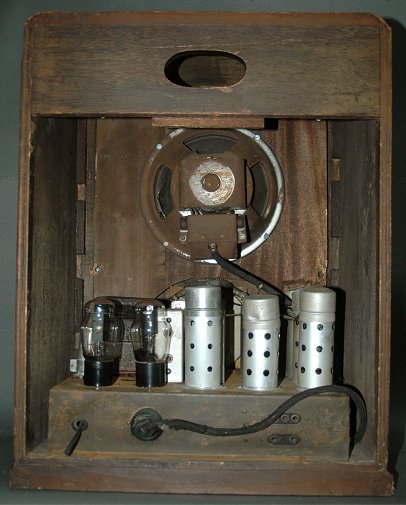
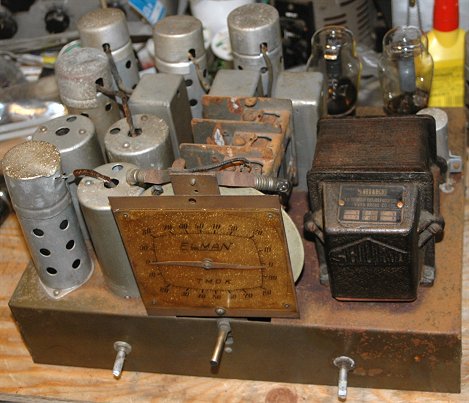
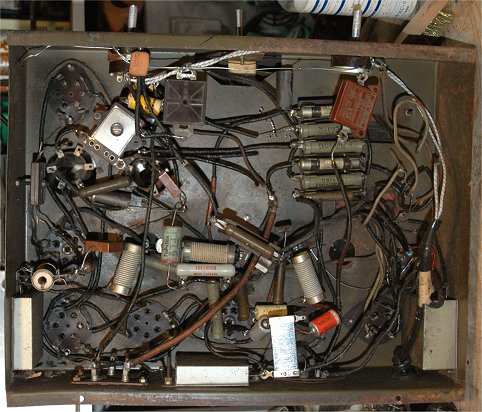
Hi-end Radios at War Time (1937-45)
CONTENTS
Japanese Hi-end Radio
Introduction
Radio and Broadcasting in Japan
Production of Hi-end Radio
5 Tubes TRF: Unique Japanese High Grade Radio
Hi-end Radios of Early 1940's
Radio Museum (UPDATED)
We difined the word "Hi-end Radio" is super heterodyne and TRF with 2 stage RF amplifiers.
NOTICE:
Gothic is latest updates.
When not mentioned specially, all prices are original retail price.
Japanese terms or company names that is untranslatable are shown in
Italics.
Introduction
Many commercial broadcasting station existed in U.S.A.
In Europe, listener
could receive many stations from neighboring countries.
Then, many super heterodyne receiver put on the US and European market
in 1930s.
However,
Japanese market was deferent from US and European market.
TOP
Radio and Broadcasting in Japan
In 1935, Japanese broadcasting celebrate 10th anniversary.
Listeners increased over 2.5 million.
Production of radio sets increased 150,000 a year
and established as industry.
Only one broadcasting company existed in
Japan.
This is "Nippon Housou Kyoukai (The Broadcasting Corporation of
Japan)".
Now It was called "NHK". This abbreviation "NHK" was used from
1946.
Until 1945, It was called "Housou Kyoukai". We will use "NHK" in
this article.
In the city 2 wave existed. In other areas only 1 wave was
presented.
The greater part of program was sent through the transit network in nationwide.
Then radio set did not need selectivity and
sensitivity.
Foreign broadcasting station using same language did not exist
around Japan.
Short wave listening was prohibited by government.
Japanese market did not need super heterodyne receiver.
Main stream of Japanese radio was poor regenerative straight receiver with 3 or 4 tubes.
Super heterodyne receiver was minority.
TOP
Production of Hi-end Radio
From 1931 to 45, in wartime, hi-end radios still existed in Japan.
From 1938, Japanese production of hi-end radios increased rapidly.
At late 1930’s, Japanese business trend was a war boom.
From 1931 to 45, in wartime, hi-end radios still existed in Japan.
From 1937, production of hi-end radios increased rapidly.
At late 1930’s, Japanese business trend was a war boom.
And the importation of foreign high-grade radio and radio phonograph was prohibited.
Then the rich people became getting Japanese hi-end radio and radio phonograph .
In 1938, The peak of production was celebrated.
The number of production in 1938 was as follows.
Super heterodyne Receivers: 72,330
Radio Phonograph: 7,347
(from statistics by METI)
It’s a 13% of total production of radio.
TOP
5 Tubes TRF: Unique Japanese High Grade Radio
In Japan, Many TRF 5 tubes (with 2 RF stage) put on the market as hi-end
set.
Typical line up was 58-58-57-2A5-80. Speaker was electro-dynamic type.
Cost and price similar to super heterodyne set.
The reason for prevailing these expensive TRF set was low engineering level.
If the local oscillator was stopped, super heterodyne receiver became out
of use.
If the tracking adjustment of TRF set was imperfect, receiver did not stop receiving.
To realize and maintaining the super heterodyne set, high quality parts
and test equipment needed.
The quality of radio parts was poor and small factory and radio shop did not have enough test equipment.
Many hi-end receivers used in the country far away from radio station.
In this area, maintaining the super heterodyne set was difficult.
The number of stations was limited.
High selectivity was not needed.
TOP
Hi-end Radios of Early 1940's
After the 08/12/1941, The produce of hi-end radio continued.
However user of such high performance radio changed from rich people to government office.
The condition of communication systems such as telephone, telegraph and postal service grew worse.
From 1943, The notification from government to prefecture transferred via radio broadcasting.
The government in prefecture needed high performance radio.
The condition of electricity also grew worse.
Battery operated super heterodyne receiver for emergency use supplied to government.
However, number of production was limited.
Radio Museum INDEX
ELMAN Model unknown 7 tubes Taiyo Radio Manufacturing Co., Ltd. 1937
?
Victor R-122(JR-122)型 6 tubes Victor Talking Machine Co. of Japan, Ltd. 1937 JPY
97.50 (Link to other file)
Nanaora Model 250 7 tubes Nanao Radio Co.,Ltd. 1938 ?
National Model 6S-10(Early type) 6 tubes Matsuahita Radio MFG. Co., Ltd. 1939 JPY 165.00
National 6S-10(Later type) 6 tubes Matsuahita Radio MFG. Co., Ltd. 1942
Victor Model R-106 5 tubes (Modified Portable) Victor Talking Machine Co. of Japan, Ltd. 1939 JPY 120.00
Victor Model 5R-70 5 tubes Victor Talking Machine Co. of Japan, Ltd. 1939 JPY
155.00 (Link to other file) (NEW)
Victor Model 6R-70 6 tubes Victor Talking Machine Co. of Japan, Ltd. 1939 JPY
185.00 (Link to other file)
Victor Model 6R-75 6 tubes Victor Talking Machine Co. of Japan, Ltd. 1940-42 JPY 207.00 (Link to other file)
Victor Model 6R-80 6 tubes Victor Talking Machine Co. of Japan, Ltd. 1942-44 JPY
171.80 (Link to other file)
Columbia Model CR-130-B 6 tubes Nippon CHikuonki Shokai K.K. 1941 JPY 207.00
Wave "Aikoku" 5 tubes Ishikawa Musen Denki K.K. 1941 JPY 84.20 (official price)
Mikasa Model SD-7 7 tubes Ogawa Musen Kogyo K.K. 1942
Hermes Model KS-6 6 tubes The Osaka Musen Co., Ltd. 1943 (Link to other
file)
TRF (with 2 stage RF amp.) Reciever
Victor Model R-103 5 tubes Victor Talking Machine Co. of Japan, Ltd. 1938
Victor Model 5R-20 5 tubes with Time Switch Victor Talking Machine Co. of Japan,
Ltd. 1938
Victor Model 5R-15 5 tubes Victor Talking Machine Co. of Japan, Ltd. 1940 JPY
125.00
Columbia Model CR-100 5 tubes Nippon CHikuonki Shokai K.K. 1940 ?
Columbia Model CR-102 5 tubes Nippon CHikuonki Shokai K.K. 1941
Seikwa Radio koshuha 2dan-shiki 5 tubes Yaou Radio Manufacturing Co.,./Koa Musen Denki Kougyosho 1942 ?
Victor Model 5R-25 5 tubes Victor Talking Machine Co. of Japan, Ltd. 1941-43 JPY
112.43 (official price / 08/1942)
Victor Model 5A-10 5 tubes Semi-transformer less Victor Talking Machine Co. of Japan,
Ltd. 1941-42、JPY 90.60 (official price)
Imported Reciever
RCA Victor Q-33型 8 tubes 5 band all wave RCA Manufacturing Co.(U.S.A.) 1940
Super Heterodyne Reciever
ELMAN Model unknown 7 tubes Taiyo Radio Manufacturing Co., Ltd. 1937 ?




TUBES: 58-2A7-58-58-2B7-2A5-80 Electro-dynamic Speaker (Nanaola)
1935年創業の新興勢力である「エルマン」ブランドの大洋無線電機の最高級受信機。普通の高一受信機より2周りは大きい高級機である。
58-2A7-58-58-2B7-2A5-80 の高一中二の7 tubesで、七欧製ダイナミックを駆動する。
このセット、エルマンのダイヤルを付けてはいるが、トランスはシーク、スピーカはナナオラ、コンデンサは日本無線など、一流メーカの部品が使われている。
銘板は無く、シャーシにエルマン製のセットを示す証拠は無い。また、当時の資料では、同社製品にこのような構成のスーパーは確認されていない。
一部にエルマンの部品を使用してラジオ商もしくは中小メーカが組み立てたものと思われる。キャビネットは市販品を使ったものだろう。
この時代、各社がスーパー受信機をカタログにラインナップしているが、生産台数は非常に少ない。
国産のスーパー受信機の流行が始まった頃のセットである。
(Collection No.11790)
Nanaola Model 250 7 tubes Nanao Radio Co.,Ltd. 1938 ?
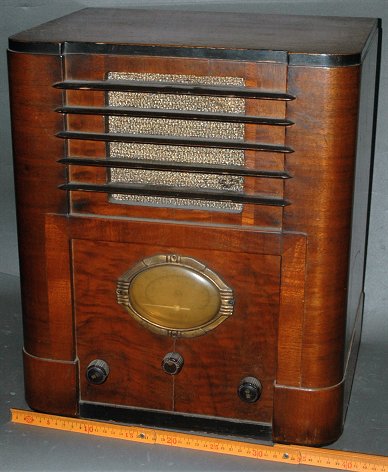
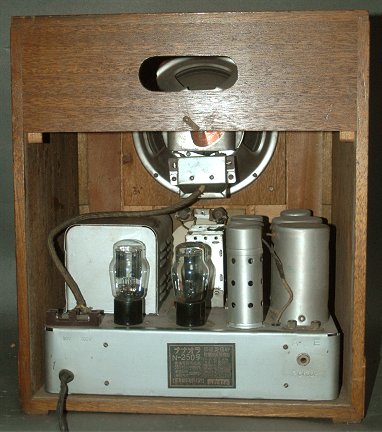
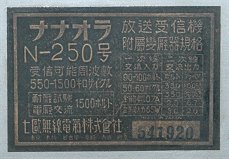
TUBES: 58-58-56-58-2A6-2A5-80 Electro-dynamic Speaker (Flower Vox D-82)
ナナオラの最高級受信機。スタイルとしてはミゼットがただが、とてもミゼットなどといえない大型の高級機である。
この時代、各社がスーパー受信機をカタログにラインナップしているが、生産台数は非常に少ない。
アメリカでは同時期にはトランスレスの5球スーパーが家庭用受信機の主流になっていたが、同じような性能の受信機を日本で作るとこのような大きなものになってしまう。日米の技術力、生産能力の差を感じさせるセットである。
本機はほぼオリジナルの状態が保たれている。
(Collection No.11378)
National Model 6S-10 (Early type) 6 tubes Matsuahita Radio MFG. Co., Ltd. 1939 JPY 165.00
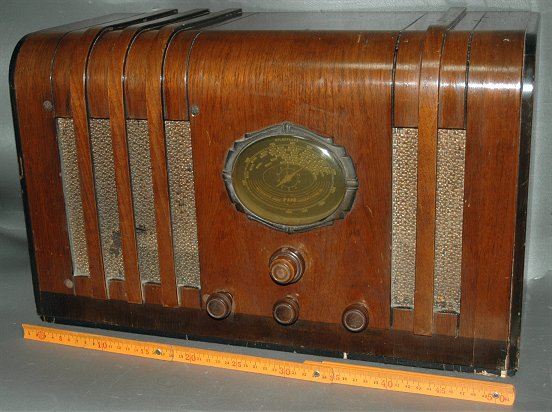
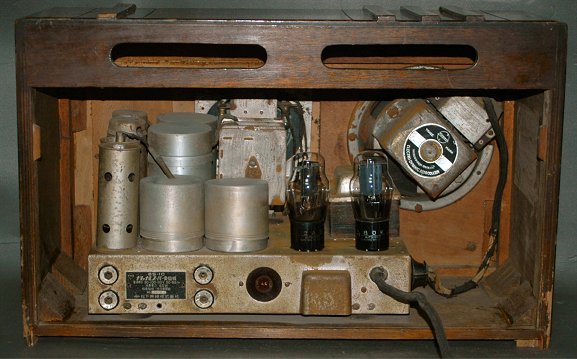
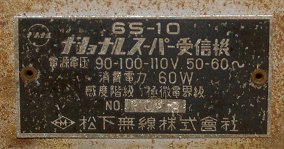
TUBES: 58-2A7-58-2A6-2A5-80 Electro-dynamic Speaker (6.5" National
Model D-65)
Model 6S-10 was Matsushita’s hi-end radio set except radio phonograph.
Call sign of foreign countries near by Japan was indicated on the dial.
I.F. was 175kc. NFB was used for AF stage to compensate tone quality.
(Collection No.11841)
National Model 6S-10 (Later type) 6 tubes Matsuahita Radio MFG. Co., Ltd. 1942
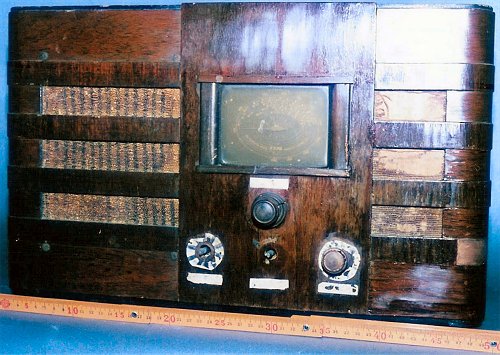
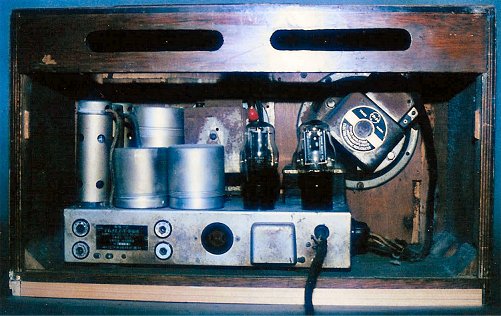
Labels around knobs were unoriginal.
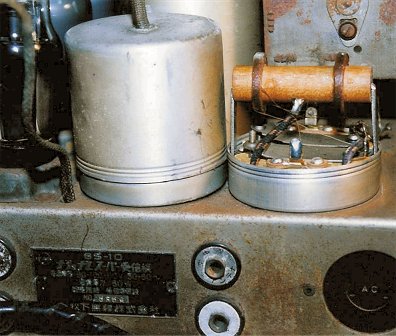
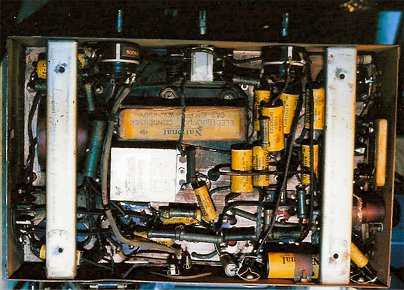
Close up of IFT(Cover was removed) The bottom view of chassis
(completely original)
TUBES: 58-2A7-58-2A6-2A5-80 Electro-dynamic Speaker (6.5" National
Model D-65)
This was minor changed model of 6S-10.
Call sign of foreign countries near by Japan was indicated on the dial.
I.F. was 175kc. NFB was used for AF stage to compensate tone quality.
(Collection No.11329)
Victor Model R-106 5 tubes (Modified portable) Victor Talking Machine Co. of Japan, Ltd. 1939 JPY 120.00
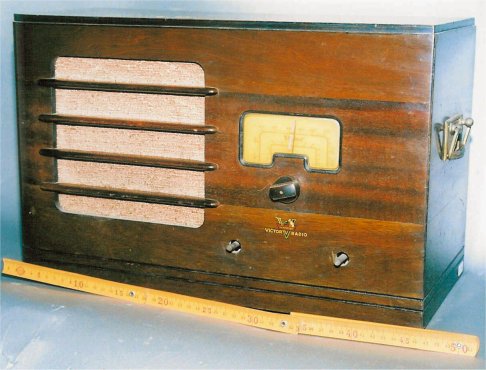
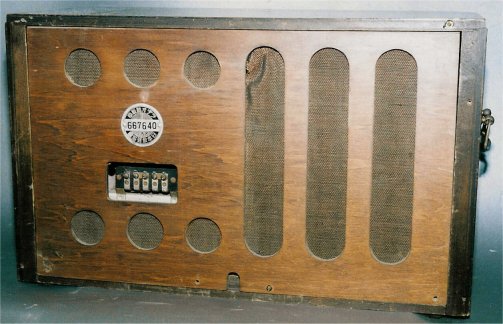
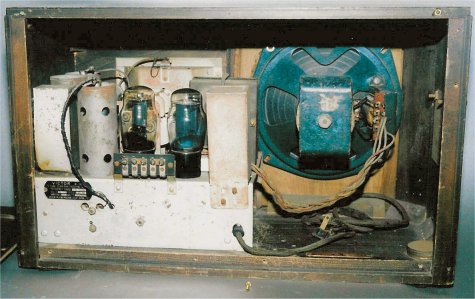
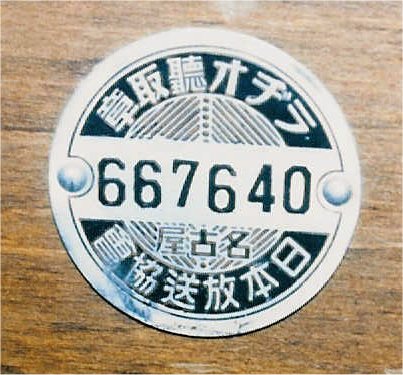
TUBES: 58-2A7-57-2A5-80 Electro-dynamic Speaker
Victorのスーパー受信機。58-2A7-57-2A5-80の配列で、高周波1段増幅で中間周波増幅を持たない回路である。IFは175kcである。
エレクトリック・マジック・ボイスと称する負帰還をかけて音質を改善している。
Victor特有の深いシャーシと非常に頑丈な作りが特徴である。
本機は左右側面に家具用と思われる「取っ手」が付けられ、通常は家庭の玄関先などに付けられる聴取章がセットの裏蓋に付けられている。
このセットは、山間部での巡回運用などのために携帯用として登録されていたものと思われる。
本機はツマミが2個失われているほかスピーカがオリジナルではない。
シャーシはほぼ原形をとどめている。
(Collection No.11499)
Columbia Model CR-130-B 6 tubes Nippon CHikuonki Shokai K.K. 1941 JPY 207.00
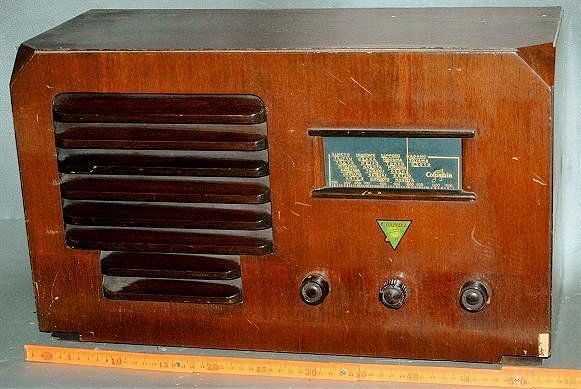
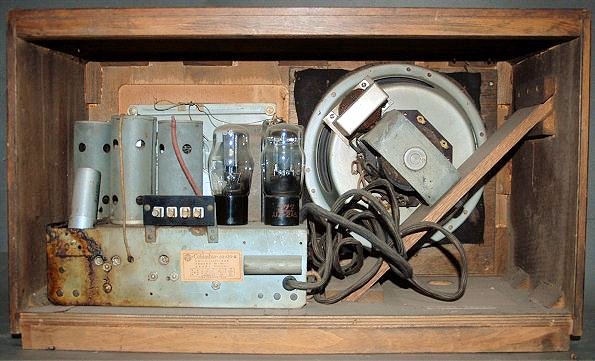
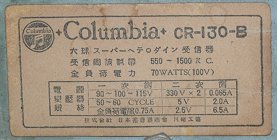
TUBES: 58-2A7-58-2A6-2A5-80 Electro-dynamic Speaker (Columbia, 9")
This model was Columbia’s hi-end radio set.
Model CR-130-B was minor changed model of CR-130 (1940).
Nippon Tikuonki Shokai (Columbia) was ex-subsidiary company of British company.
The design of this set was British modern style.
Chassis was supplied from Victor Talking Machines Co., of Japan.
Speaker was original equipment.
(Collection No.11476)
Wave "Aikoku" 5 tubes Ishikawa Musen Denki K.K. 1941 JPY 84.20 (official price)
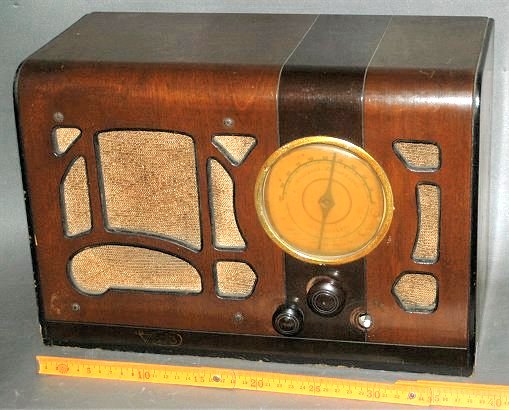
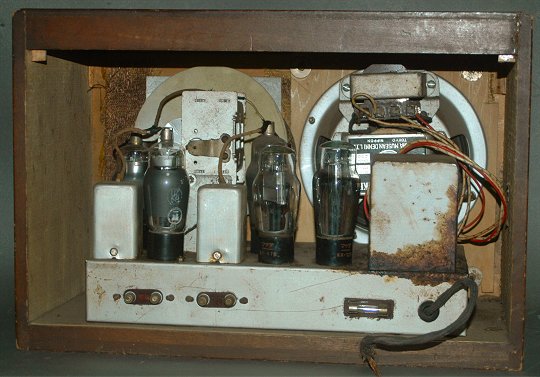
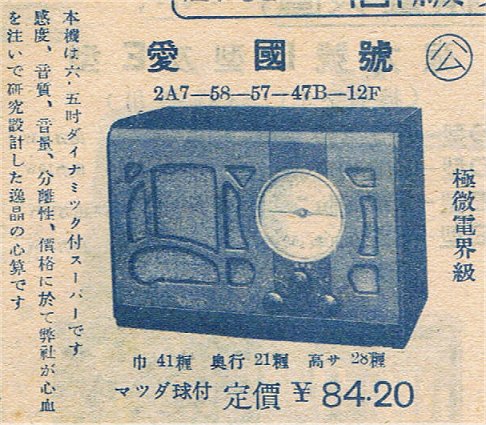
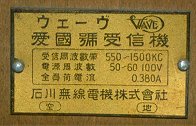
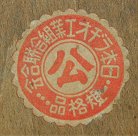
from Rengo retail catalogue 03/1941(left), Name Plate (center), Label of Standardized
Set (right)
TUBES: 2A7-58-57-47B-12F Electro-dynamic Speaker (6.5")
This set was standardized low cost super heterodyne receiver.
Official price was lower than hi-end TRF set using 2A5 tube.
Cabinet was simplified and small.
One of the knobs was missing.
Chassis kept original condition. But power transformer failed.
(Collection No.11725)
Mikasa Model SD-7 7 tubes Ogawa Musen Kogyo K.K. 1942
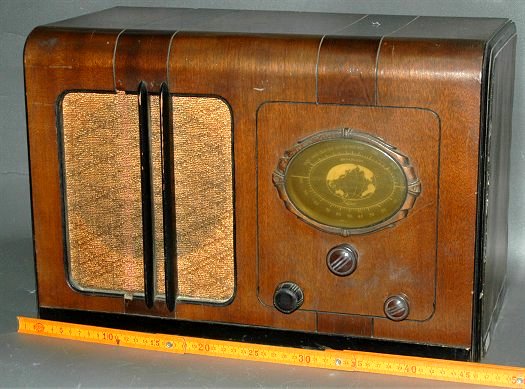
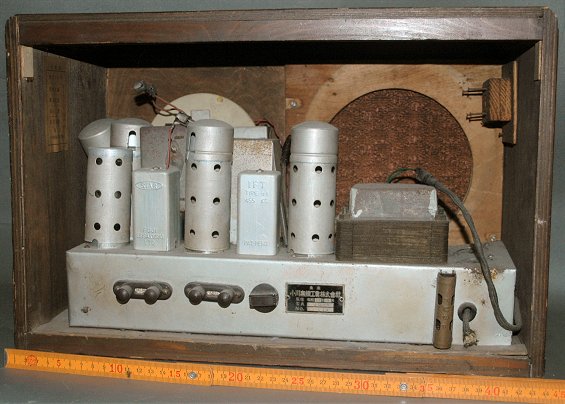
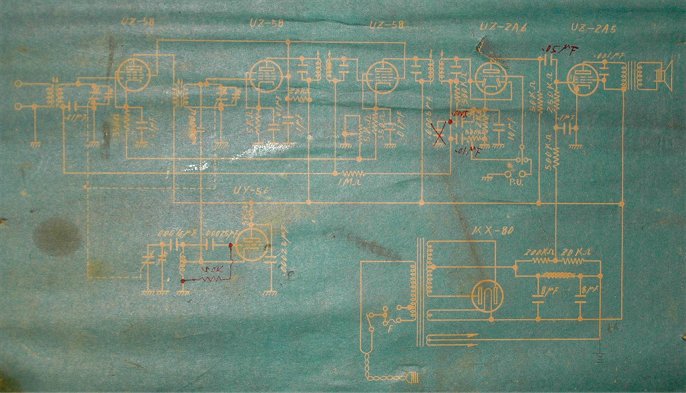
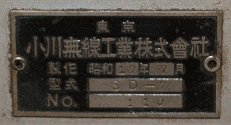
TUBES: 58-58-56-58-2A6-2A5-80 Electro-dynamic Speaker
1937年創業の新興メーカー、小川無線工業のスーパー受信機。
太平洋戦争が激化した頃のセットだけに粗悪な部品やつくりの悪さが目立つ。
本機はスピーカーのグリルの一部とスピーカーが失われている。
また、IFT、コイルが戦後のスター製品に交換されている。
(Collection No.11493)
TRF (with 2 stage RF amp.) Reciever
Victor R-103型 5 tubes Victor Talking Machine Co. of Japan, Ltd. 1938
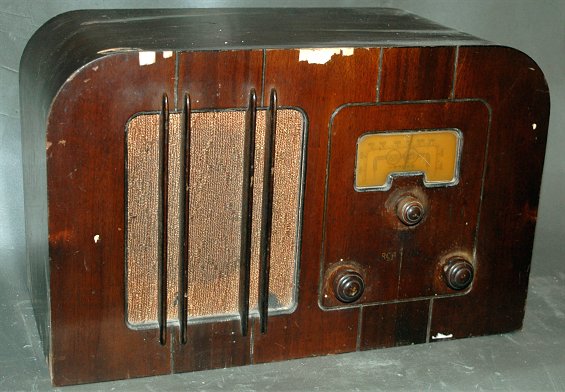
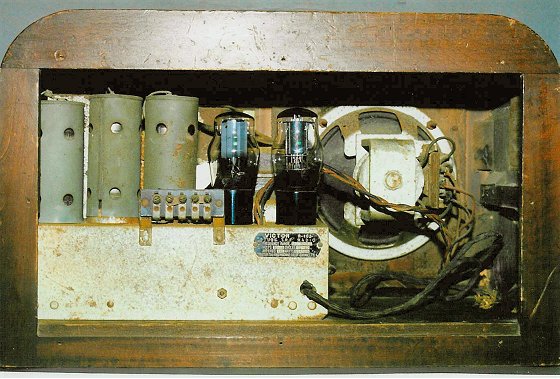
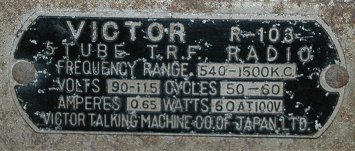
TUBES: 58-58-57-2A5-80 Electro-dynamic Speaker
Victorの高二受信機。
非常に深いシャーシはVictorラジオの特徴である。このため整備性は悪い。
ダイヤルにはRCAとVictorのマーク、「日本Victor」の文字が並んでいる。
シャーシの構造や部品にはライセンスを結んでいたアメリカの影響が見られ、品質は非常に高い。
本機は前面パネルのツキ板にはがれが見られる。また、裏蓋が失われている。
(Collection No.11421)
Victor Model 5R-20 5 tubes with Time Switch Victor Talking Machine Co. of Japan, Ltd. 1938
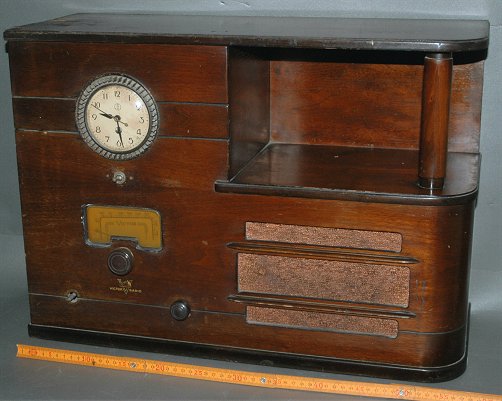
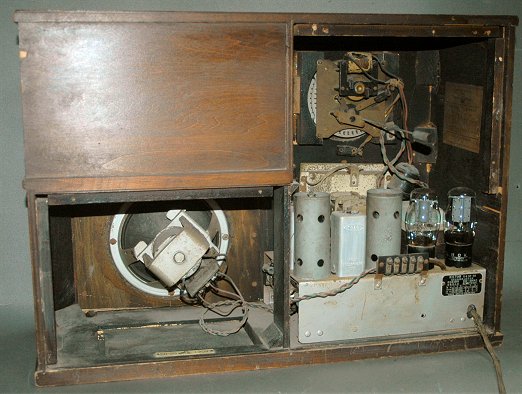
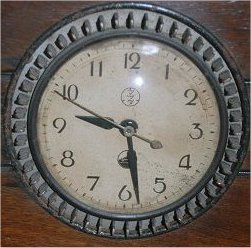
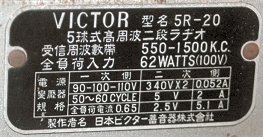
TUBES: 58-58-57-2A5-80 Electro-dynamic Speaker
高二5 tubes に、東京電気製タイムスイッチを組み込んだもの。任意のピンを引き出すことで指定した時刻から一定時間ONすることができた。
飾り棚を備えた時計塔型のユニークなキャビネットで、ラジオ部が左側にあるデザインも特異なものだが、シャーシは同社の平均的なものと共通である。
タイムスイッチを備えたセットには、この他にデザインが異なる5R-22型があった。
本機は、戦後、市販のコイルを組み込み、トランスを交換して6.3Vのスーパー(6WC5-6D6-6ZDH3A-42-80K)に改造されている。
ツマミはオリジナルではない。
(Collection No.11704)
Columbia Model CR-100 5 tubes Nippon CHikuonki Shokai K.K. 1940 ?
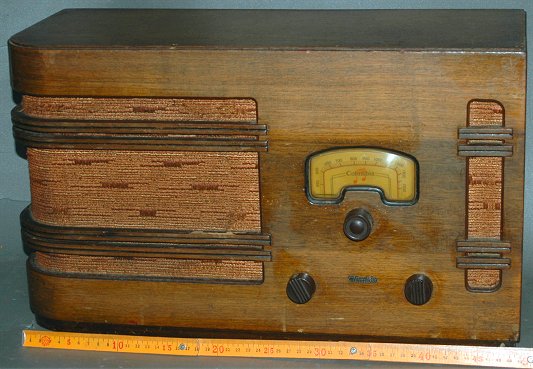
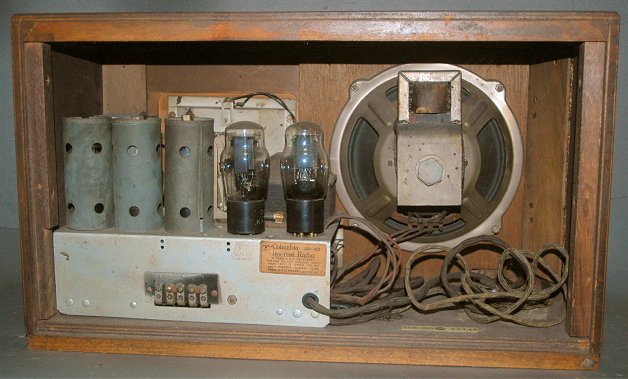
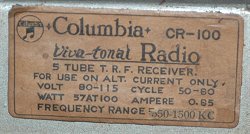
TUBES: 58-58-57-2A5-80 Electro-dynamic Speaker (8")
Columbiaの大型受信機。58-58-57-2A5-80 の平均的な構成で自社製8インチフィールド型ダイナミックを駆動する。
シャーシはVictorのOEMである。音質改善のためNFBがかけられている。
銘板が紙製になるなど、資材不足からの簡素化がはじまっている。
(Collection No.11169)
Columbia Model CR-102 5 tubes Nippon CHikuonki Shokai K.K. 1941
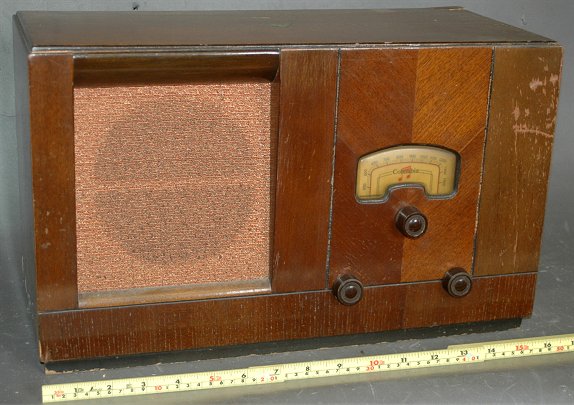
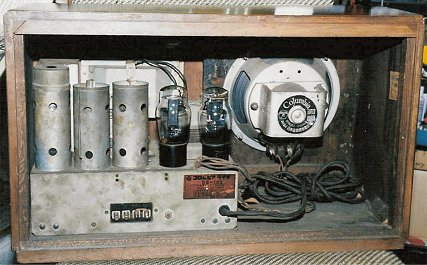
TUBES: 58-58-57-2A5-80 Electro-dynamic Speaker (Columbia Model 107)
Columbiaの大型受信機。
シャーシはVictorのOEMである。音質改善のためNFBがかけられている。
敵性語排除の動きからか、銘板の表記が日本語に改められている。
(Collection No.11342)
Victor Model 5R-15 5 tubes Victor Talking Machine Co. of Japan, Ltd. 1940 JPY 125.00
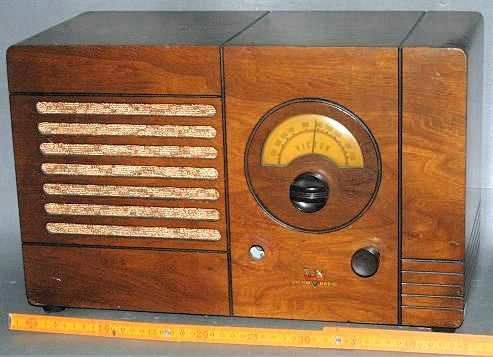
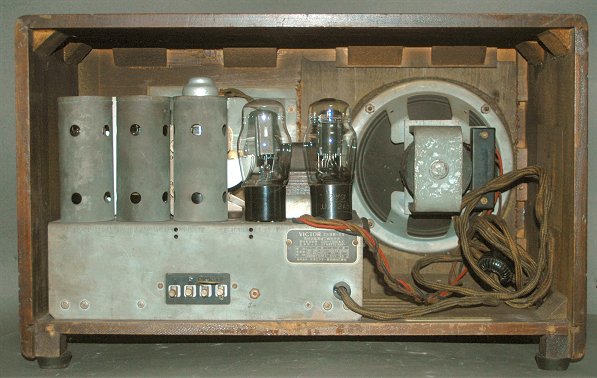
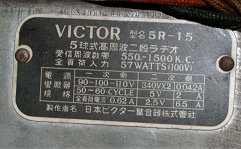
TUBES: 58-24B-24B-2A5-80 Electro-dynamic Speaker
This was Victor’s middle class TRF set.
Old fashioned tetrode 24B was used.
Design was simplified according to national policy at wartime.
Model 5R-15 was changed into Model 5R-25 next year.
The shaft of power switch was broken.
(Collection No.112727)
Seikwa Radio Koshuha 2 dan-shiki Yaou Radio Manufacturing Co.,./Koa Musen Denki Kougyosho 1942 ?
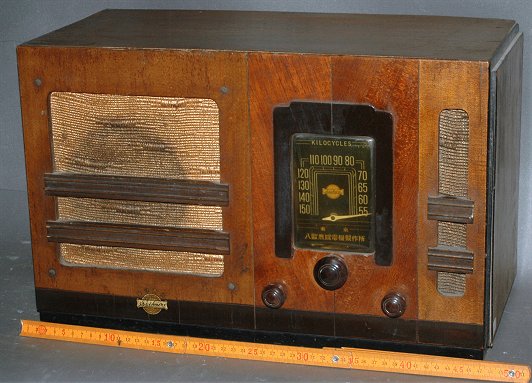
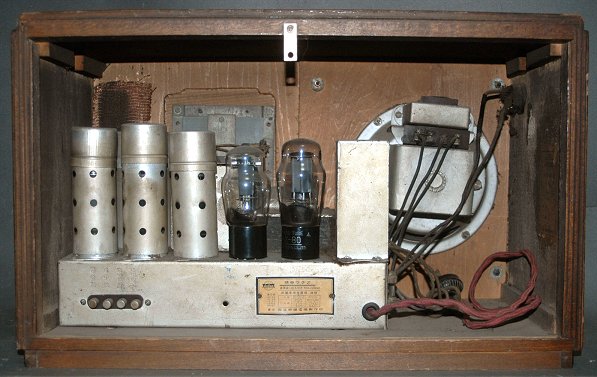
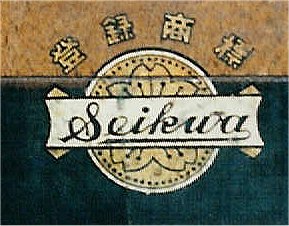
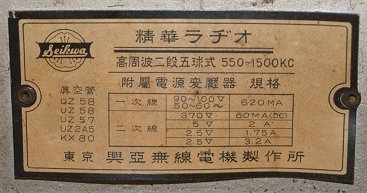
Logo Mark (left), Name Plate (right)
TUBES: 58-58-57-2A5-80 Electro-dynamic Speaker
Koa Denki Seisakusho was established in 10/1938 as manufacturer of phonograph
They changed company name into Yaou Radio Manufacturing Co., in 06/1941.
Yaou was well known as “General” brand. They used this brand after the war.
Their early brand was “Seikwa” measn "the flower".
They started production of radio set from early 1940’s.
At that time, Japan went to war with united nations, The productions of Seikwa radio was limited.
This hi-end TRF set was their early products.
They continued their business. Their company name is Fujitsu General now.
(Collection No.11495)
Victor Model 5R-25 5 tubes Victor Talking Machine Co. of Japan, Ltd. 1941-43 JPY 112.43(official price at 08/1942)
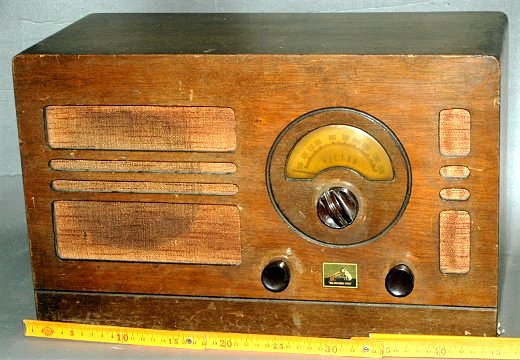
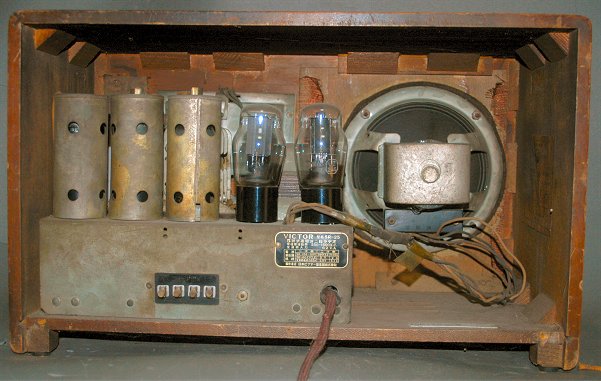
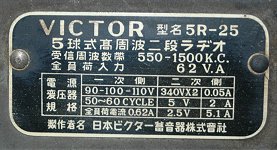
TUBES: 58-58-57-2A5-80 Electro-dynamic Speaker (Victor, 6.5")
This was Victor’s middle class TRF set.
This model was revised model of 5R-15. Tube was changed from 24B into 58.
Design was simplified according to national policy at wartime. Quality
kept high level against the lack of resources.
(Collection No.11221)
Victor Model 5A-10 5 tubes Semi-transformer less Victor Talking Machine Co. of Japan, Ltd 1941-42 JPY 90.60 (official price)
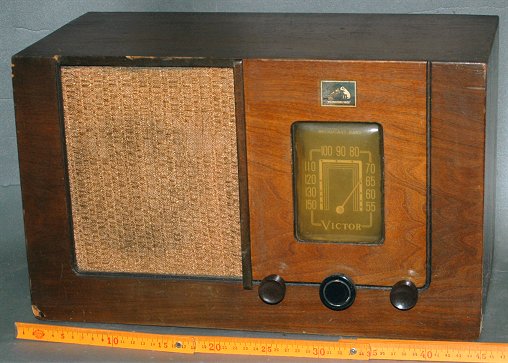
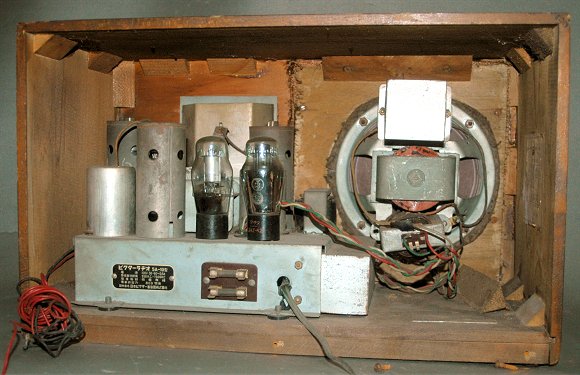
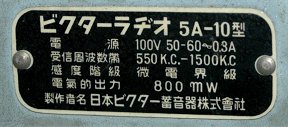
TUBES: 12YV1-12YV1-12YR1-12ZP1-24ZK2 Electro-dynamic Speaker
This set used interesting circuit.
Transformer-less tubes were used.
Heater was connected series.
The 2 units of multiplying rectifier tube 24Z-K2 used for 2 half-wave rectifiers.
One used for B power supply, other one used for field exciter.
Small auto-transformer was used for boosting B voltage.
AC mans connect to chassis directly, Chassis was isolated from enclosure.
This model was “material saving” hi-end set.
Knob (center) is unoriginal.
Appeared on the magazine "Radio no Nippon" 05/1940issue
(Collection No.11571)
Imported Reciever
RCA Victor Model Q-33 8 tubes 5 band all wave RCA Manufacturing Co.(U.S.A.) 1940
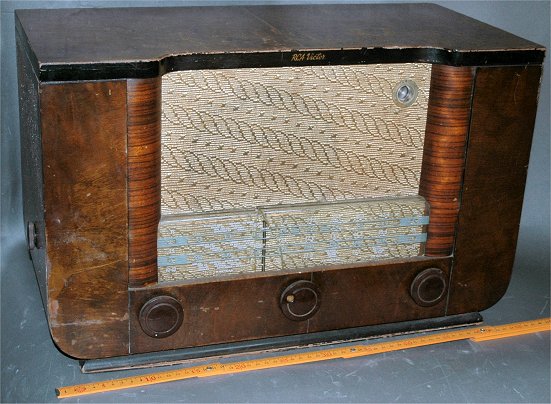
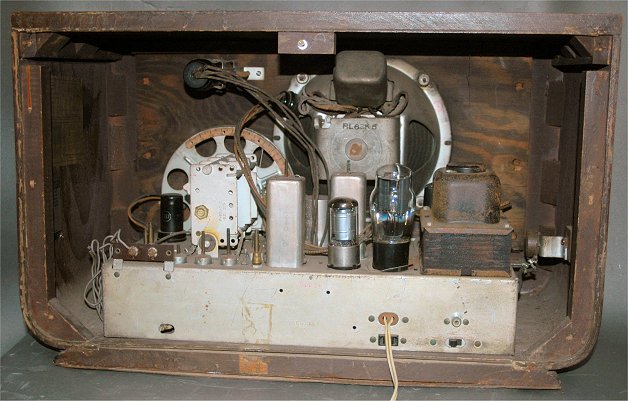
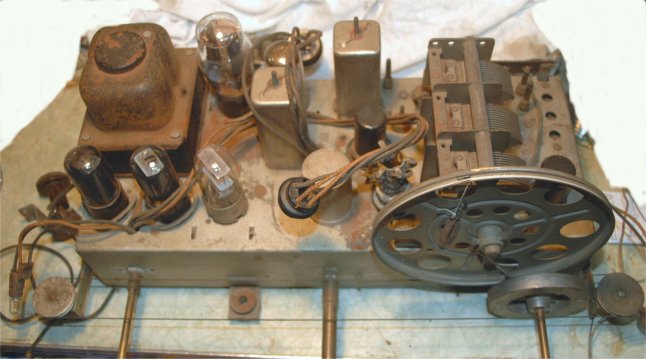
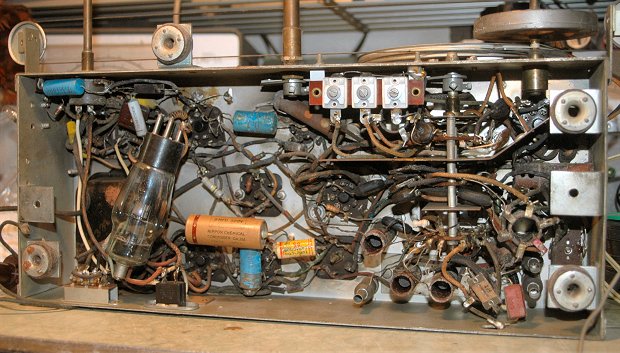
Modified chasssis, 6AD7 was
changed into 6F6+85.
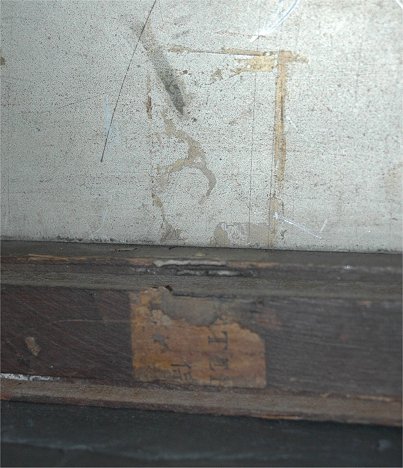 Seal to prohibitting short wave listening
Seal to prohibitting short wave listening
TUBES: 6SK7-6SA7-6SK7-6SQ7-6AD7G-6F6G-5Y3G-6U5/6G5 Electro-dynamic Speaker
(8")
太平洋戦争開戦直前のRCA製高級全波受信機。メタル管とG管で統一された高一付5バンドである。
この機種は輸出用を考慮され、トランスのタップにより100-130,140-160,200-250Vを切り替えることができる(アメリカ国内用もあった)。
3極5極管6AD7の3極部を位相反転に使い、5極部と6F6でプッシュプルとして自社製8インチフィールド型ダイナミックを駆動する。
高周波部は、中波のほかに3-22.5Mcの短波帯を4つに細かく分け、生産性を向上させると共に放送が多い部分を拡大することで操作性の改善を目的とした「バンド・スプレッド方式」を採用している。
バンドスイッチツマミは中央にあるが、ロータリースイッチはバリコンの下に配置されている。
このため、ツマミが付いているシャフトからリンクを介してスイッチを動かしている。
キャビネットは幅54.5cm、高さ34.5cmの大きなもので、頑丈に作られている。
あらゆる面で当時の国産品よりはるかに高い技術レベルと高品質を実現している。
本機は戦前に日本に入ったものらしく、シャーシに封印した形跡が見られるが、短波の回路を改造した形跡は見られない。
ツマミを外すか封印する程度の処置が行われていたものと思われる。
本機は、「ラヂオの日本」誌1943年1月号に、電気通信協会の委嘱により技研の技師による解説記事が掲載されている。
南方向け輸出のための参考ということだが、6頁にわたる詳細な記事である。
この機種のバンドスプレッド方式や、シャーシ構造、回路構成などは、Victorが戦後すぐに発表した5AW1型「黎明」受信機に大きな影響を与えている。
本機は、戦後も修理を繰り返されながら長く使われたようである。
3極5極管6AD7は入手が困難だったらしく、6F6に改造し、位相反転部は、3極部の相当管UZ-85(マツダ製放出品)をシャーシ下に押し込んでいる。
本機は、キャビネットの保存状態が悪く、ダイヤルガラスが破損している。
(Collection No.11651)